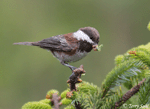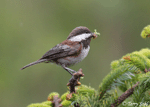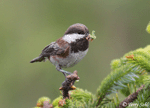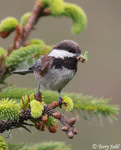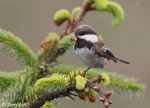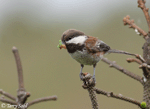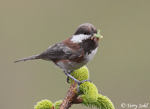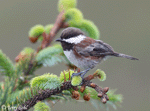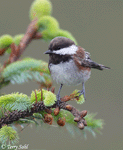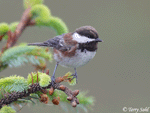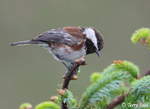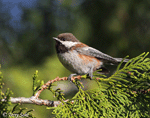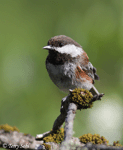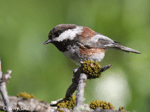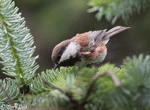| Length: 4.75 inches | Wingspan: 7.5 inches | Seasonality: Non-resident in South Dakota |
| ID Keys: Chestnut on back unique for North American Chickadees, smallest Chickadee, range in western North America | ||
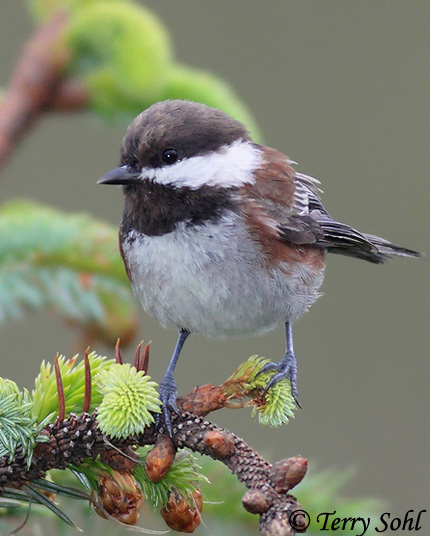 Chestnut-backed
Chickadees are among the most colorful of the different chickadee species in
North America, and are also the smallest and shortest tailed chickadees.
The dark chestnut back is unique for this chickadee, and makes it readily
distinguishable from the other chickadee species which overlap in range in the
northwestern U.S. and western Canada. In winter, mixed flocks of
Chestnut-backed Chickadees, Mountain
Chickadees, Red-breasted Nuthatches,
Brown Creepers, and
Golden-crowned Kinglets can often
be seen foraging together in range.
Chestnut-backed
Chickadees are among the most colorful of the different chickadee species in
North America, and are also the smallest and shortest tailed chickadees.
The dark chestnut back is unique for this chickadee, and makes it readily
distinguishable from the other chickadee species which overlap in range in the
northwestern U.S. and western Canada. In winter, mixed flocks of
Chestnut-backed Chickadees, Mountain
Chickadees, Red-breasted Nuthatches,
Brown Creepers, and
Golden-crowned Kinglets can often
be seen foraging together in range.
Habitat:
In the moist conifer forests of spruce, hemlock, or fir along the Pacific Coast, Chestnut-backed Chickadees are typically the only chickadee species present. They will use dense conifer forests throughout their range, if present. In the southern part of their range, they also will use mixed pine and oak woodlands, and riparian woodlands.
Diet:
Insects and spiders make up about two-thirds of the typical diet. Berries, seeds, and fruti are also consumed, depending upon availability and season.
Behavior:
Foraging behavior typically includes clambering and hopping from branch to branch in search of insects or other food items. They will often start in the lowest branches of a tree, work their way up, and then move to the bottom of a nearby tree to repeat the process. They will also sometimes act like flycatchers, flying out from a perch to snag insects that are passing by.
Nesting:
A cavity nester, primarily nesting in cavities in trees, including old woodpecker holes or nesting holes built by other birds. Will also excavate own cavity in dead and rotting wood. Nesting birds often return to use the same nest hole in subsequent years.
Song:
Lacks musical song or whistles, with an accelerating series of chip notes functioning as a song.
Migration:
Generally non-migratory, although birds may move short distances in the fall and winter in search of suitable foraging grounds.
Interactive eBird Map:
Click for access to an interactive eBird map of Chestnut-backed Chickadee sightings
Similar Species:
Mountain Chickadee, Boreal Chickadee, Black-capped Chickadee
Conservation Status:
Numbers appear to be stable throughout most of its range. Local declines may be noted where suitable nesting holes are destroyed.
Feeders:
Nuts, sunflower seeds, peanut butter.
Birdhouses:
Will nest in birdhouses designed for Chickadees.
Further Information:
1)
BirdWeb.org - Chestnut-backed Chickadee2) WhatBird - Chestnut-backed Chickadee
3) Audubon Guide - Chestnut-backed Chickadee
Photo Information:
June 28th, 2011 - Ecola State Park, Oregon - Terry Sohl
Additional Photos:
Click on the image chips or text links below for additional, higher-resolution Chestnut-backed Chickadee photos.
| Click on the map below for a higher-resolution view |
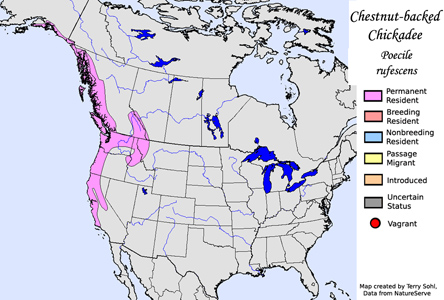 |
| South Dakota Status: Non-resident in South Dakota |
Additional Chestnut-backed Chickadee Photos
Click for a higher-resolution version of these photos
